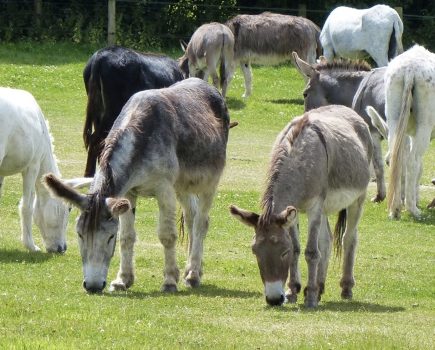How much do you know about your feathered friends? Try our fun quiz and see if you have counted your chickens before they’ve hatched!Â
Q1 Which of these hens would you expect to provide a regular supply of eggs, and also be suitable for a beginner?(a) Indian Game(b) Black Rock(c) SilkieQ2How could you tell what colour eggs a hen is likely to lay?(a) By the colour of her plumage(b) By the colour of her legs(c) By the colour of her ear lobesQ3 Why would you require a cockerel?(a) To get revenge on annoying neighbours(b) So that the hens lay eggs(c) To fertilise eggs Q4You need to register with DEFRA if you have:(a) Any poultry at all(b) Over 50 birds at any one time(c) At least 100 chickensQ5 The family are keen to get away for a few days, but what about the hens?(a) They’ll be fine if you leave them enough food and water(b) You explain to the family that holidays are now out of the question(c) You ask a neighbour to look after them, or pay an ‘animal sitter’Q6 What should you not feed to poultry?(a) Table scraps(b) Lettuces and cabbages(c) BreadQ7You’ve been told that chickens need to have grit available. Why is this?(a) To make strong eggshells(b) To sharpen their beaks(c) To help grind their foodQ8 You notice quantities of grey dust in the henhouse. Is this because:(a) The hens have been having a lot of dust baths recently(b) The bedding is dusty(c) You have an attack of red miteQ9One of your hens has lumpy looking legs. Do you suspect:(a) Scaly leg(b) Arthritis (c) Bumble footQ10Why do chickens need dust baths?(a) For relaxation(b) To clean their feathers and skin(c) To try to disguise themselves from predatorsQ11It’s spring, and one or two hens have lost several feathers from their backs. What is most likely to be the cause?(a) Depluming mite(b) An over-attentive cockerel(c) MoultQ12One of the hens has been sitting in the nest box all day and refuses to come out. She looks puffed up and her breast feels hot. Do you suspect:(a) She’s egg-bound(b) She’s ill(c) She’s broodyQ13Your broody hen has settled on the eggs and is sitting well – too well. She hasn’t left the nest at all. What should you do?(a) Leave her alone(b) Offer her some food and water in situ(c) Remove her from the nest to feed and drinkQ14How long will your broody need to sit on a clutch of chicken eggs before they start to hatch?(a) 28 days(b) 21 days (c) 35 dayQ15Out of a clutch of 10 chicks, seven have turned out to be cockerels. What is likely to be the most practical option?(a) To cull them, or grow them on as table birds(b) Try to rehome them(c) Let them stay with the flockQ16It’s late summer and two hens have gone broody, taking over two nest boxes and causing chaos in the henhouse. Some eggs are getting broken, and others are being sat on by the broodies. What would be the best course of action?(a) Put up with it, and let the hens sort themselves out(b) Put the broodies to sit on some eggs (c) Remove the broody hens to a separate run, where there’s nowhere to sitQ17 It’s autumn and a few of the hens are beginning to look alarmingly bedraggled. Their combs are shrinking, and they’ve lost all their tail feathers. Do you suspect:(a) They’re moulting(b) It’s old age(c) They’ve got an infectionQ18 You need to catch one of the flightiest hens. Do you:(a) Spend several hours stalking her (b) Wait until she settles down in the henhouse for the night(c) Chase her until one of you collapses with exhaustionQ19A sick hen needs to be put down. Will you:(a) Do so, having been taught the correct humane technique(b) Take her to the vet(c) Do nothing, hoping she’ll recover eventuallySo, have you counted your chickens before they’ve hatched?To find out, check your answers below.SCORES:18-20. Congratulations! You are an egg-spert.12-17. You’re getting there.0-11.  Read more copies of Poultry!Q1 (b) Black Rocks are known as hardy, reliable layers of good sized brown eggs. Indian Game have been developed as table birds, and are unlikely to produce an abundance of eggs. Silkies are fluffy rather than feathery, and very attractive, but they are not regarded as good layers, and are famous for being obstinately broody.Q2 (c) Hens with white ear lobes usually lay white eggs.Q3 (c) The only reason for having a cockerel is to fertilise eggs for breeding. Hens don’t need a cockerel to lay. Care should be taken that neighbours are not disturbed by the birds. A complaint may mean that you aren’t allowed to keep any hens at all.Q4 (b) DEFRA need to be informed if you have more than 50 birds (including chickens, ducks, guinea fowl, geese etc.) on the premises at any one time during the year. There’s a registration form on their website.Q5 (c) It’s worth giving some thought to this before deciding to keep poultry. Even if holidays aren’t important, there are likely to be times when you need to be away from home. A neighbour or friend might be prepared to help, otherwise a professional ‘pet sitter’ may be needed. Make sure that whoever is caring for the hens knows what is required, and what to do should there be a problem. Poultry (or any animals) should be checked at least daily, ideally twice, to ensure they are in good health and have adequate food, water and shelter. Chickens need to be securely shut in at dusk for protection from predators. Q6 (a) Feeding table scraps to poultry is no longer allowed. Most green vegetables are fine, and if hung up in the run will give the hens something to peck at, as well as adding variety to their diet. Bread can be fed, but is best for an occasional treat, as the hens will tend to fill up on this to the detriment of more nutritious feed. It’s also worth remembering that, if you use commercially produced bread, it will contain salt, and perhaps other additives.Q7 (c) Chickens need grit to help grind food in their gizzards. Crushed oyster shell will provide a calcium supplement if egg shells are too thin.Q8 (c) Grey dust on ledges in the henhouse is a sign of red mite. Other signs are chickens being unwilling to go into the henhouse at night,and a decline in egg laying. Prompt action is needed, as red mite will suck the birds’ blood, causing anaemia and even death. There are proprietary sprays and agents to deal with mite, but mite are notoriously hard to eradicate, and both birds and house will need thorough treatments.Q9 (a) The ‘wrinkled stocking’ look is likely to be caused by the scaly leg mite, and this also shouldn’t be ignored. The scales on the hen’s legs are pushed up and chalky crusts can be seen underneath. The hen will be very itchy and uncomfortable, and may even become lame. Proprietary treatments are available, although many poultry keepers have their own methods. Q10 (b) Chickens need dust baths to clean themselves. Free-range hens will make their own (often in the lawn!), but confined chickens will need to have a dust bath provided. Excessive dust bathing may be a sign of lice or mites.Q11 (b) Back feathers can be lost due to the cockerel’s attentions, especially if he singles out a particular hen as his ‘favourite,’ or if too many cockerels are kept. Keep an eye on the feather loss, as the unfortunate hen may be bullied or pecked by the others if her skin is exposed or broken. It may be wise to put her in a separate enclosure for a rest if the problem persists. Q12 (c) A broody hen will puff herself up, and squawk peevishly if moved. When set down, she may slump on the ground for a few moments, before suddenly springing to life and rushing off to feed and drink – usually shrieking madly. Q13 (c) It’s good for both the hen and the eggs if she leaves the nest at least once a day for a few minutes. Often hens do this naturally, but some need to be carefully removed from the eggs – make sure she’s done a dropping before putting her back. On the day when the eggs are expected to hatch, it’s best to leave the hen alone.Q14 (b) Hens’ eggs take 21 days to hatch from when incubation starts (not from when they are laid). Bantam eggs may hatch a couple of days earlier, while guinea fowl and duck eggs take 28 days.Q15 (a) There are nearly always excess cockerels in a clutch of eggs, and unless the breed is auto-sexing, this probably won’t become evident until they start to mature. Depending on the breed, they may make good table birds (some might not be worth the trouble), otherwise a responsible solution must be found. Occasionally good homes can be found for surplus male birds, but they are often difficult to place, and care should be taken that their welfare isn’t compromised. Keeping several cockerels with the flock will often lead to fights, which in some cases will be to the death. The hens will also find too much male attention exhausting, and may stop laying.Q16 (c) Broodiness can be discouraged by putting the hen in a slatted or wire bottomed pen (making sure she has food and water and is safe from predators). This will make it more difficult for her to sit, and stop her interfering with the other hens and their eggs. Some breeds are very determined, so it may take a while for the message to sink in. Late summer is not an ideal time of year for a hen to start incubating eggs.Q17 (a) Some hens hardly lose any feathers during their moult, whereas others look as if they’ve been through a wind tunnel. Although loss of feathers may be due to many causes, if the hens seem otherwise well, it’s likely to be due to moulting, which usually occurs in late summer or autumn. Moulting takes a lot out of the hen, and she will usually stop laying.Q18 (b) Once the hens are asleep, it is easy to take them gently from the perch, and while they are in darkness they will usually remain quiet. Chasing hens is counter productive, especially if they are free range, as they are extremely difficult to catch, and the stress will be harmful (both for them and for you). Q19 (a) There will be times when a hen has to be put down, and ideally the owner should be able to perform this task correctly and humanely (there are courses available). If this isn’t possible, the hen should be taken to the vet for despatch. A sick or injured animal should never be left to suffer.







